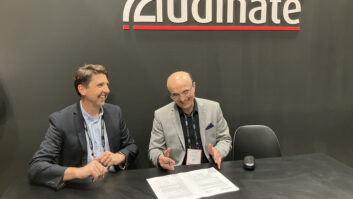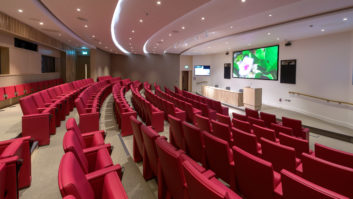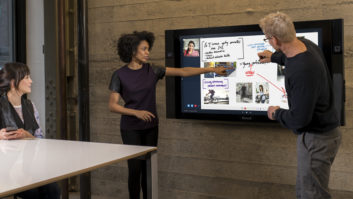For this networked AV feature we’ve got insights from a range of players to understand the current landscape and preview how things will evolve over the next few years in this technology space.

In what way does the growing influence of the IT department alter the design and deployment of networked AV solutions?
At a high level, IT managers want their AV products to function like the rest of the products on their network. This means a number of things… first, products that can be networked on standard IP infrastructure are critical, as IT managers don’t want to procure and manage separate networking infrastructure specifically for AV products. Next, security is top of mind for the entire IT department, and AV products need to fit into the security framework IT managers have deployed for the rest of their network. This means allowing for user-level access control and authentication, as well as device-level security best practices. Finally, they want the same network management and diagnostic capabilities that are commonplace with other IT products, but are relatively new when it comes to AV devices.
Do you envisage any potential problems with AV and IT convergence?
I think another challenge with AV and IT convergence is the traditional AV industry learning to effectively communicate with the IT department. Another challenge is fixing the misconception within the IT world, that AV networking relies on proprietary or non-standard protocols.
How do you see networked AV projects evolving over the next few years?
First, I think the biggest trend will be the proliferation of networked AV projects. During a recent focus group with AV and IT managers, it was clear that nearly every new medium to large scale AV project being considered is assumed to be networked. This represents a big shift from just a few years ago. Second, I think you will see more manufacturers and integrators deliver the tools and features that are important to IT managers. Whether that is enhanced security features or network management software like Dante Domain Manager, these will make the dialogue with the IT department easier, and lead to more networked AV projects. For Audinate, we will continue to invest in enhancing the Dante platform with the features that are important to the IT department.
I do see a lot of development on conferencing and there’s a lot of innovation occurring there. I also see the retrofitting of non-networked technologies with tools like Dante AVIO adapters to bring them onto the network and that’s making the networked universe larger and more powerful.
What’s your vision of the networked AV endgame?
To get the best vision of what the AV industry will look like in the future, one just needs to look at the evolution of the IT industry in general. As AV becomes just another system on the network, it’s not a stretch to imagine a world where AV is shaped by software-based solutions rather than bespoke hardware, operating in virtualised environments and enhanced by cloud-based services. A great blueprint for the AV industry is how corporate telecommunications evolved over the last 15 years. What was once a separate department with bespoke PSTN/POTS systems has now almost 100% migrated to VoIP solutions running on the main corporate network, deployed and managed through the cloud.
There is a term called ‘the network effect’, which basically supposes that the value of a network grows exponentially with each additional node (or person or product) that is added to the network. The network effect tends to create a dominant solution since interoperability is critical, versus a landscape of disparate, incompatible technologies. With Dante’s dominant market share and rapid adoption by the market, I believe that Dante is very well positioned to be that preferred protocol for the AV industry.

As a consultancy, how easy is it to advise and operate in the current networked AV landscape?
As part of our company ethos at MiX we strive to help our clients to create a converged networked environment. While some organisations see convergence as a risk, many clients have embraced this approach and are now seeing benefits in the way they manage and deploy their AV estate. New clients are very much open to the idea at the beginning of the project as long as the impact of implementing AV equipment onto the corporate network is detailed and set out.
Are more manufacturers designing networked AV products with IT managers in mind rather than integrators?
Overall I feel that manufacturers are slowly starting to understand the needs of the client and not focusing on the integrators, however the documentation on deploying devices on a client network is still very much focused on the AV integrator.
A number of manufacturers are now moving to cloud-based models and developing software platforms to enable global enterprises the ability to deploy new systems at a more controlled and rapid rate. The majority of this change is being driven by the unified communications strategy within organisations.
As the convergence of AV and IT spreads, do you envisage any potential problems with AV on the IT network?
I don’t see any problems with AV being deployed on the network, that said I think the security element of networks is a high priority within larger organisations. This is an area that is constantly under review, and manufacturers and integrators will need to be certified to work within a client’s enterprise network and the AV industry as a whole will be required to be more regulated.
How do you see networked AV projects evolving over the next few years?
AV as a service is a topic discussed regularly at the moment but to take it a step further I believe we will see the majority of manufacturers moving away from the traditional ‘black box’ hardware and working on developing software-based solutions which will provide flexibility and scalability. Hardware will have a place for the foreseeable future for larger spaces but software-based solutions will allow certain types of rooms to potentially be driven from a user’s peripheral device, without the new for additional hardware to enable an enhanced collaboration.
What’s your vision of the networked AV endgame?
I think the future will be a primarily cloud-based deployment for AV services, the majority of corporations are already pushing some of the major IT services to the cloud as it saves on both physical space and overall operational costs. AV manufacturers will need to adapt this model in the future to fall in line with the practises the majority of corporate IT departments are doing.
Currently there are many different standards for a number of technologies and one of the biggest challenges is interoperability. In this future of cloud/software-based solutions, manufacturers need to work together to ensure they are making constant development of standards, but also ensuring that they can interact with other IT solutions you would typically see on a corporate network.







